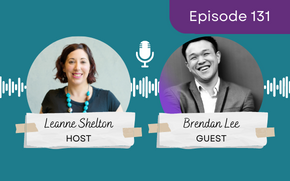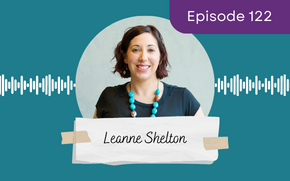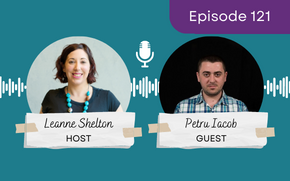
Ep 131 – Brendan Lee: Investing into the right marketing channels
Today, I’m chatting with Brendan Lee about managing your marketing budget – which includes both planning and playing with where you put your money.
Nov 20, 2020
Are you happy with your current website – or does it need a major overhaul?
If your business has been through big changes lately – I mean whose business hasn’t? – it’s probably a good time to take another look at it and ensure the content still reflects what everything looks like now.
And the direction you’re now heading in. As I record this episode, I’m about to start re-jigging my own website for this exact reason. I’ll let you all know when it goes live!
And I’m sure there are listeners out there who still don’t have a website – for various reasons.
Today, I’m sharing 5 key tips that I believe every engaging and effective website should have. These tips have been extracted from my Website Boosters Bootcamp – which is a course that will soon be available to purchase from my website.
Let’s get started!
RESOURCES
SEO tools –
https://tools.pingdom.com/
https://sitechecker.pro
Tony Cosentino – https://www.wpguy.com.au/
ROUGH TRANSCRIPT
Lately, I’ve been working on a bunch of website jobs – and everyone has been in the health and wellness space – which is awesome!
So I thought I’d share my top 5 tips for ensuring you have an engaging and effective website.
1.Ensure your messaging is clear
First of all, before you start working on your website, you need to get your message right. And that comes from knowing your audience, their pain points, and how you provide solutions.
You also need to have a clear idea of how you want your brand to be perceived.
When asked to write website copy – or any copy for that matter – for my clients, I ask them to fill out a project brief. This gives me a better understanding of the business – such as the background, target market, tone of voice, unique selling point, competitors, and SEO.
I NEED this information so I can write in line with the brand.
So YOU need this information clear in YOUR mind before you can write your content. Or brief the copywriter!
Otherwise, your content can miss the mark. You want to speak directly to your ideal buyer.
Who is my ideal client/s?
How old are they? Where do they live? What’s their family life like? Where do they work?
What are their 5 main pain points?
What keeps them up at night? Is it regarding money? Stress? The kids? Work in general?
Now think – how do my products and/or services address these pain points?
How can you solve their problems?
What makes me unique?
Why should people buy from you vs your competitor? Is it your strong customer service? Is it your personality? Is it the price-point? Is it the convenience factor?
What’s my tone of voice and personality?
Do you want to be perceived as friendly? Quirky? Professional? Serious?
Now, you might be wondering what all of this stuff has to do with your website.
Well, this messaging needs to come through in your content.
The words you use.
The phrases you use.
Those pain points can be used as hypothetical questions on your homepage or at the start of each of your services’ pages.
You want to get your audience nodding along – and eager to hear what you have to say.
It’s not all about your products and services.
And this is the trap many business owners fall into.
Your products and services mean nothing if you haven’t pinpointed the need first.
People need to see the value in what you’re offering.
So they need to first think about themselves – yes, it sounds a bit selfish – but they need to know how you can make their life either a little or a lot better. Ideally, a LOT better!
And being clear on your tone of voice and personality is all about your personal branding.
People need to connect with you – not your business.
People do business with people.
Not all people will like you. And that’s okay. But the right people will. And you want to work with those types of clients.
They’re less likely to be a pain in the bum!
2. Ensure it’s SEO friendly
Search Engine Optimisation (SEO) is key if you want to appear ‘organically’ in Google.
In other words, have a chance of appearing in searches – without paying for Google ads. From the search engine’s perspective, if you can say a ‘bot’ has a perspective, it wants to present the user with the most useful and relevant content according to their search.
Where you appear in the search pages – and whether you even appear at all – relies upon numerous factors, such as:
This is where my expertise usually comes in.
It’s important to choose one keyphrase per page.
When putting together your website content, consider the long tail keyword phrase you want to link to each page.
A long tail keyword is another way to describe a sentence potential customers type into Google when searching for you.
After you’ve picked one, think of the synonyms. Aka – similar words or phrases that might be used. Everyone thinks differently and can search for different things.
You need to incorporate these words in the webpage – ideally in the main and subheadings.
On that note – this is why you need to have separate pages for each of your services. If you have multiple services listed on a page, then you’re likely to have multiple keywords – making Google confused about where to direct people.
Also ensure they’re added to the ‘Focus keyphrase’ section in the website backend.
Another factor involved in SEO is –
Inbound links
This is where an authoritative site includes a relevant link to your website in a piece of content. These are also referred to as ‘backlinks’.
You can achieve these by getting a guest blog or article published elsewhere on a news site or another highly engaged website.
Google used inbound links as one way to help determine how authoritative and relevant your content is. So you want as many of these as possible!
Outbound links
These are links to external relevant and authoritative sites in your industry. It shows Google you’re creating quality and well-researched content for your visitors.
For example, you can include a definition or phrase from an industry association or government website.
Internal links
Providing links to your own content can help tie pages together for both Google and your visitors, making each page more valuable.
So you might refer to other blogs in your blogs. Or insert links to your contact page and blog from your services page.
This all increases engagement on your website. So Google can see users are finding your website content useful – and the bots are more likely to push your site up the rankings for others to see.
And finally, the last SEO factor to consider is –
So yeah, there are quite a few factors at play!
And there’s no perfect formula. There’s no guaranteed way to appear on the first page of Google. And you can’t just work hard on it in one month – then leave it alone.
Working on your SEO needs to be an ongoing process.
This is because the Google algorithm changes constantly. In fact, according to my research, they change the search algorithm around 500 to 600 times each year. Insane, right?!
You just need to do your best.
There are some free SEO tools you can use to see how your website is tracking.
These include –
https://tools.pingdom.com/
And
https://sitechecker.pro (Very thorough!)
I also recommend Tony Cosentino from the WordPress Guy who does low-cost website health checks.
3. Talk about the humans behind the business.
And this can be achieved via an About page.
About pages are a topic close to my heart – but so many websites don’t have one. Or they only feature the company’s history.
I actually get disappointed when I find an About Page that only features more facts and figures about the business.
The About page should be about the people. The people behind the brand. You need to show the human side – and don’t be afraid to include some personality!
It’s your opportunity to ‘network’ with potential buyers so they know who they’re really dealing with.
The page can feature the founder’s personal journey into the business. Why did you start the business? Was there some form of catalyst?
You can cover your experience and expertise and feature links to media coverage etc.
You can even talk about your hobbies and family life – which can become a conversation starting point with new clients.
I recommend including a photo of you and/or the team as well. To further help with the connection.
Real photos are better than stock photos. Although the odd one is okay!
4. Have clear call to actions
You need to tell viewer what they need to do next!
You can have multiple call to actions throughout each page – but don’t ever leave them hanging and feeling unsure about how they can contact you. Don’t just rely on the contact page.
If someone is convinced that they want to work with you from reading one paragraph on a Services page – encourage them to call you or book an appointment with you by supplying an easy to find link.
5. Include a blog
Yes, as someone who loves writing and repurposing blogs, this needed to be included in the list!
From an SEO perspective, blogs help keep your website fresh. Especially if you haven’t touched the content on your other pages in years…
Sense of brand loyalty
(Why should people choose you?)
Show you are trustworthy & transparent
Show you’re the industry expert
Discuss issues, concerns, & interests
You can listen to Episode 1 of this podcast ‘How to build a blog friendly business’ to find out more about the benefits.
But ultimately, if someone is driven to your blog via a Google search, social media post, or email, you then have them in the perfect place to click around your site to find more about you. And then potentially buy from you – either then and there or at a later point.
Yes, it can be time-consuming to write them. But just remember, they act as wonderful core pieces of content.
Once published, you can:
So there are my 5 tips for creating an engaging and effective website.
To recap:
BOOK A FREE 30 MIN DISCOVERY CALL WITH LEANNE
https://calendly.com/leanneshelton/30min




Start a conversation
ABN: 11 061 860 249